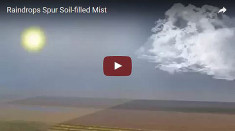Scientists have found that rain triggers the release of a mist of particles from wet soils into the air, a finding with consequences for how scientists model our planet’s climate and future. (Credit PNNL)
This article was adapted from a news release by Pacific Northwest National Laboratory.
Rain’s reputation for cleansing the air may come with a caveat after new study findings show that they play a role in generating airborne organic particles.
The surprising results, published today in the journal Nature Geoscience, show that when droplets hit the dirt, particularly in grasslands and tilled fields, they launch a mist of microscopic particles into the air.
The mechanism begins as organic matter in the soil dissolves in the puddles when it rains. Subsequent raindrops create air bubbles in the puddles that mix with the dissolved matter. The bubbles float upward and quickly burst, releasing into the air a mist of the soil organic compounds.

When droplets hit the soil surface, air bubbles form in puddles containing dissolved soil organic matter (SOM). The bubbles burst at the air/water interface and eject airborne soil organic particles (ASOP) that solidify to become glassy particles on drying. The insert in the upper left corner shows a scanning electron micrograph image of glassy ASOP collected after a rainstorm in Oklahoma. (Credit Nathan Johnson, PNNL)
The authors of the study are from the U.S. Department of Energy’s Pacific Northwest National Laboratory, the Lawrence Berkeley National Laboratory and the University of Massachusetts at Amherst. Chemist Alexander Laskin, lead scientist of the paper, is a senior research scientist at PNNL.
A research team led by Mary Gilles, staff scientist at Berkeley Lab’s Chemical Sciences Division, gathered samples of airborne particles at DOE’s Atmospheric Radiation Measurement Climate Research Facility in Oklahoma. Under the microscope, scientists noticed spherical, glassy particles in the air samples. They were so anomalous that Gilles thought there was a mistake, scribbling in her lab notebook, “Something is wrong with these samples.”
The Gilles group at the Berkeley Lab’s Advanced Light Source and the Laskin group at PNNL’s Environmental Molecular Sciences Laboratory analyzed the particles using advanced chemical imaging tools to confirm that the tiny particles were composed of organic matter from the soil.
The findings could influence how scientists model our planet’s climate and future.
Click here to read the full PNNL press release.
